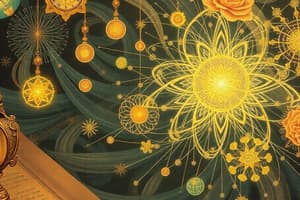Podcast
Questions and Answers
Boyle's Law describes the relationship between two gas properties when another property is held constant. Which two properties are changing in Boyle's Law?
Boyle's Law describes the relationship between two gas properties when another property is held constant. Which two properties are changing in Boyle's Law?
- Pressure and Temperature
- Pressure and Number of Moles
- Pressure and Volume (correct)
- Temperature and Volume
Which statement correctly describes the relationship between volume and pressure in gases at constant temperature?
Which statement correctly describes the relationship between volume and pressure in gases at constant temperature?
- As pressure decreases, volume increases. (correct)
- As pressure remains constant, volume increases.
- As pressure increases, volume remains constant.
- As pressure increases, volume also increases.
Sean can still pump air into a party balloon even after it's already inflated. Which of the following best explains this phenomenon?
Sean can still pump air into a party balloon even after it's already inflated. Which of the following best explains this phenomenon?
- Balloons are made up of plastic.
- Air molecules can be compressed. (correct)
- Balloons look better if their size is bigger.
- The air inside the balloon is hot.
Which of the following conditions must remain constant when applying Boyle's Law?
Which of the following conditions must remain constant when applying Boyle's Law?
Air is pumped into a bicycle tire. Which of the following does NOT occur as a result?
Air is pumped into a bicycle tire. Which of the following does NOT occur as a result?
A sample of hydrogen gas has a volume of 30 L under a pressure of 5 atm. According to Boyle's Law, what will be the pressure of this gas be if the volume is decreased to 5 L, assuming constant temperature?
A sample of hydrogen gas has a volume of 30 L under a pressure of 5 atm. According to Boyle's Law, what will be the pressure of this gas be if the volume is decreased to 5 L, assuming constant temperature?
A balloon with a volume of 2.0 L is filled with a gas at 3 atmospheres. If the pressure is reduced to 1.2 atmospheres without changing the temperature, what will the new volume of the balloon be?
A balloon with a volume of 2.0 L is filled with a gas at 3 atmospheres. If the pressure is reduced to 1.2 atmospheres without changing the temperature, what will the new volume of the balloon be?
Which of the following is held constant when using Charles' Law to analyze gases?
Which of the following is held constant when using Charles' Law to analyze gases?
According to Charles' Law, what happens to the volume of a gas when its temperature decreases, assuming constant pressure and amount of gas?
According to Charles' Law, what happens to the volume of a gas when its temperature decreases, assuming constant pressure and amount of gas?
Which of the following best represents Charles' Law graphically?
Which of the following best represents Charles' Law graphically?
Flashcards
Boyle's Law
Boyle's Law
Describes volume-pressure relationship in gases at constant temperature. As pressure decreases, volume increases.
Compressibility of air
Compressibility of air
Air molecules can be compressed, allowing more air to be pumped into an already inflated balloon.
Temperature and Volume Relationship
Temperature and Volume Relationship
When temperature of a gas decreases, its volume goes down.
Compressibility of Gases
Compressibility of Gases
Signup and view all the flashcards
Celsius to Kelvin Conversion
Celsius to Kelvin Conversion
Signup and view all the flashcards
Temperature and Pressure Relationship
Temperature and Pressure Relationship
Signup and view all the flashcards
Tire Explosion in Summer
Tire Explosion in Summer
Signup and view all the flashcards
Saturated Fat
Saturated Fat
Signup and view all the flashcards
RNA and DNA Sugars
RNA and DNA Sugars
Signup and view all the flashcards
Nutrition Facts Label
Nutrition Facts Label
Signup and view all the flashcards
Study Notes
- Boyle's Law describes the relationship between pressure and volume of a gas when temperature is constant.
- Robert Boyle was the English scientist who studied the volume-pressure relationship.
- As pressure decreases, volume increases in gases at constant temperature.
- Air molecules can be compressed, explaining why you can still pump air into an already inflated balloon.
- Mass and temperature need to remain constant when using Boyle's Law.
- Air density increases when air is pumped into a bicycle tire.
- When the volume of a container of gas is lessened, the pressure will increase.
- The pressure of the gas inside a balloon increases when the balloon is pressed.
- Falling leaves does not involve the application of gas pressure.
- If a sample of hydrogen gas has a volume of 30 L at 5 atm, decreasing the volume to 5 L will result in a pressure of 30 atm.
- A balloon with a volume of 2.0 L filled with gas at 3 atmospheres, reducing the pressure to 1.2 atmospheres results in a volume of 5 L.
- Pressure is constant when using Charles' Law.
- When the temperature of a gas goes down, the volume also goes down.
- Oxygen gas is highly compressible at high pressure and expandable at high temperature.
- To convert from Celsius to Kelvin, the formula K = °C + 273 is used.
- As temperature increases, gas pressure increases if the amount and volume of gas are kept constant.
- The high incident of tire explosions in summer is attributed to high temperatures causing the air inside the tire to expand.
- A balloon with a volume of 200 mL at 30°C, submerged in hot water to obtain a temperature of 50°C, will have a volume higher than 200 mL if the pressure remains the same.
- As temperature increases, the molecules within a gas move more quickly, so a helium balloon will crumble on a cold day.
- Heating an aerosol can may cause it to explode.
- A 420 mL sample of gas at 25.0°C compressed to 210 mL, with constant pressure, results in a temperature of 149 K.
- Heating a sample of helium gas from 15.0°C to 30.0°C, causing it to expand to 585 cm³, means the original volume of the helium gas was 556 cm³.
- Gases exert pressure is a property explained by the Kinetic Molecular Theory.
- Pressure refers to forces exerted by molecules on the wall of a container due to collisions.
- The postulates of KMT explain why the scent of brewed coffee fills a room because gas particles are in constant motion and move independently of each other.
- According to kinetic molecular theory, gas particles do not move in predictable patterns.
- Air inside a syringe is an example with particles that can be drawn closer to occupy a smaller volume.
- As the temperature of a gas increases, the kinetic energy of its particles increases.
- Fruits and vegetables are the best carbohydrates to include in a diet
- Carbohydrates are composed of carbon, hydrogen, and oxygen.
- Glycogen, cellulose, and starch are all classified as polysaccharides.
- Fats cause a person to gain more weight, since burning 1 gram of fat releases twice the heat energy as burning 1 gram of starch.
- Monomer: polysaccharide is not a correct monomer-polymer pair
- Sucrose is not a disaccharide.
- Lipids are composed of carbon, hydrogen, and oxygen.
- Fats, waxes, and oils are lipids.
- Junk food contains unhealthy saturated fatty acids.
- Healthy fats cannot cause plaque buildup.
- Saturated fats are linked to an increased risk of heart disease.
- There are 8g of protein in one serving of whole milk.
- There are 8g of fat are in one serving of whole milk.
- There are 0g of fat are in one serving of skim milk.
- You will get 4% of your recommended daily value of carbohydrates in one serving of whole or skim milk.
- The sugar in RNA is ribose but in DNA it is deoxyribose
- Oxygen base is not part of a nucleotide.
- You should eat enough protein in your diet to maintain a healthy body with a steady supply of amino acids.
- The main purpose of enzymes is to speed up and direct chemical reactions.
- Nucleic acids can determine the traits of an organism
- Bread contains a greater amount of carbohydrates
- Sucrose is not a disaccharide.
- Proteins and carbohydrates contain the elements C-H-O and function to supply energy.
- Lipids regulate metabolism is a function of the organic molecule.
- Nutrition facts provide detailed information about a food's nutrient content.
- Eating a food that is rich in saturated fat is not an excellent way of monitoring the amount of biomolecules in the body
- ZnSO4 and Cu are the products in the equation Zn + CuSO4 -> ZnSO4 + Cu.
- Formation of a precipitate explains curdling of milk (formation of solid chunks on top of the milk) as an evidence of change
- The symbol used to indicate "reacts with" in chemical equations is the plus sign.
- O2 + C6H12O6 are the reactants in the reaction O2 + C6H12O6 -> CO2 + H2O + ENERGY.
- An arrow symbol with delta on top in a chemical equation means the container became hot (in this case)
- Combustion reaction occurs when the reaction has oxygen as one of its reactants and produces carbon dioxide and water as its products
- Sucrose (C12H22O11) and oxygen are the reactants in the equation Sucrose (C12H22O11) + Oxygen -> Carbon Dioxide + Water + Heat
- Carbon dioxide and oxygen are not the products found in that equation
- Reactants are written on the left and products on the right in a chemical equation.
- Matter can neither be created nor destroyed in a chemical reaction, according to the Law of Conservation of Matter.
- Li(s) + F2(g) → LiF(s), O2(g)+ N2(g) → NO2 are all examples of a combination reaction.
- Pb(s) + FeSO4(aq) → PbSO4(s) + Fe(s) is an example of single replacement
- AB→ A + B represents the general equation of a decomposition reaction.
- CaSO4(aq) + Mg(OH)2(aq) → Ca(OH)2(aq) + MgSO4(aq) is an example of a double replacement reaction.
- Oxygen and water are always present in the products of a combustion reaction.
- Combination is the type of reaction when water is added to Quicklime (CaO)
- Spoilage of fresh fish and meat not stored in a refrigerator is caused by the presence of microorganisms.
- During a chemical reaction, atoms are rearranged.
- In a chemical reaction, the law of conservation of mass applies.
- Directly burning dry wood causes a change in its molecular and atomic structure.
- Bubbles prove evolution of gases
- Manganese dioxide is an example of a catalyst.
- Acid + Base → Salt + Water is a neutralization reaction.
- Hydrogen + Hydroxide is present in reactants during an Acid and Base Reaction
- The mass of the reactants in the beginning of the reaction, which is 25 g, must be equal to 25 grams at the end of the reaction to follow the law of conservation of mass.
- The first reactant is 17g, the 2nd reactant must be 13g if the mass of the product is 30 g.
- If pieces of zinc metals form from sulfuric acid solution, the generation of gas in production are bubbles formed from "hydrogen".
- The law stating that the total mass of reactant should equal the total mass of product is known as the Lav of Conservation of Mass
- Fuel, heat and oxygen are necessary for burning to occur, this is known as the triangle of fire
Studying That Suits You
Use AI to generate personalized quizzes and flashcards to suit your learning preferences.




